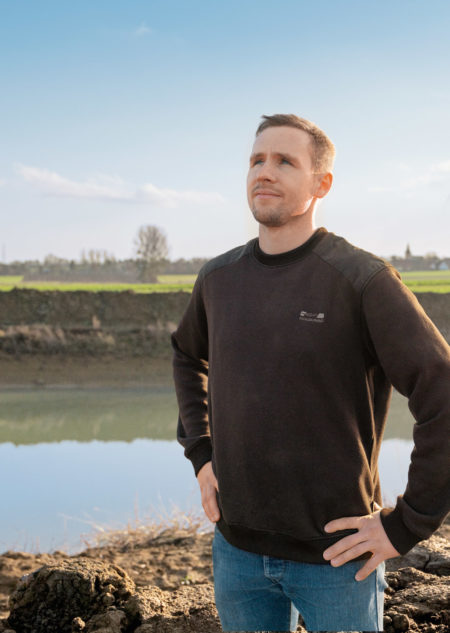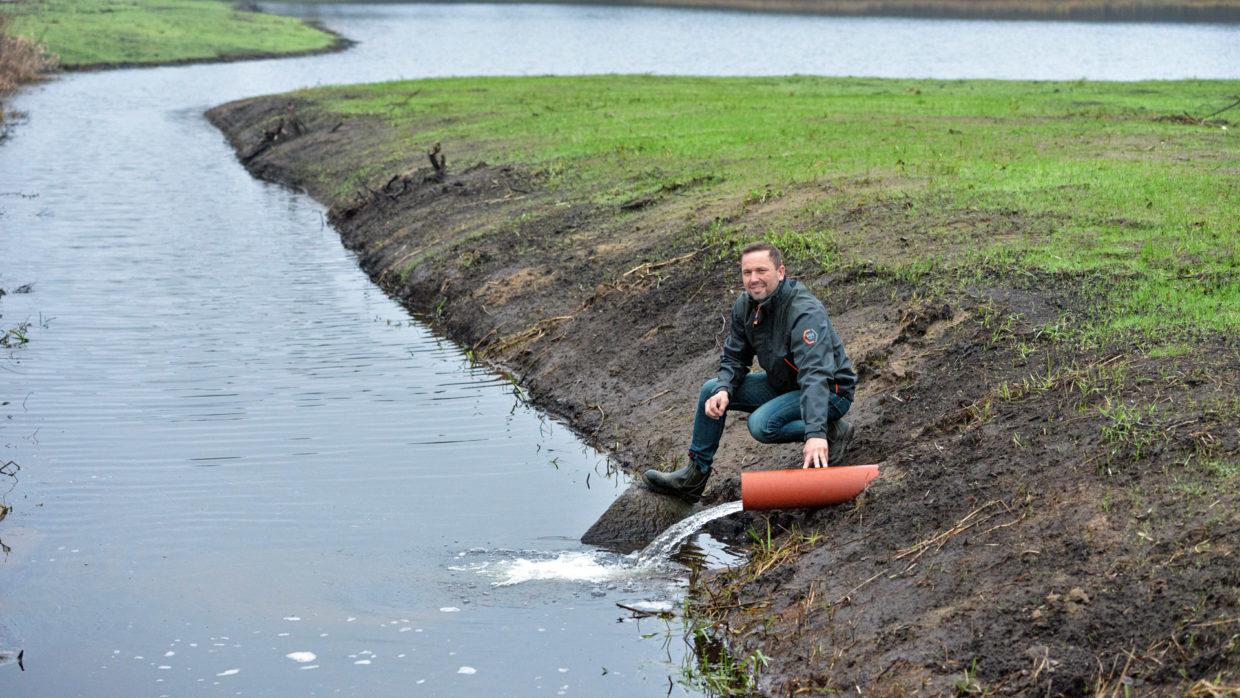Summer 2018: In Sweden, temperature records were being rewritten almost daily. Some areas went for three weeks without rain, a first in this northern climate. Nicklas Göransson, farming 300ha of potatoes, onions, carrots and grain, saw his yields fall by 25% during the season as his pivot irrigation did not allow him to counterbalance the effects of heat, due to a lack of water. “We couldn’t irrigate the small grain,” he recalls a year later.
His potatoes yielded only 30-40t/ha, 10t less than expected, and his onions 40t/ha instead of 50t. Barley yields fell by 25%. Still, he did better than many of his colleagues – according to the Lantmännen cooperative, the average Swedish grain yield fell by 45% in 2018.
Warming
Throughout Europe, droughts are putting more and more farmers under pressure. In a scenario of high carbon emissions, heat waves like those of the last two years, or even more intense, will be repeated every two years in the next 30 years, according to the European Environment Agency. This would increase irrigation needs by 25% by 2100. In the southern part of the continent, non-irrigated field crops could experience yield drops of up to 50%.
A worrying situation. However, average annual water resources remain stable in most countries, and have even increased in some (infographics p12). Preserving water when it is available in order to use it later is therefore a common-sense approach. Retention basins, hillside reservoirs, and agronomic solutions exist, and more and more producers are considering them.
Sweden: investment in the future
In early 2018 Mr Göransson started construction of his water retention system, which was completed a year later. It consists of a 30,000m3 drainage-fed basin coupled with a wetland, and is connected to the nearby Helgeån River. The drained water flows into the basin and when it reaches saturation a pipe redirects excess water to the marsh, where it is stored. Conversely, if there is not enough rain to fill the pond and marshland, water from the Helgeån River can be used.
The marshland brings biodiversity.
Nicklas Göransson
“It’s an investment in the future,” says the producer. Two thirds of his irrigated areas are still supplied by a self-drilled well, but the neighbouring town of Kristianstad is planning to use groundwater as well. Mr Göransson therefore expects quotas to be set on how much ground water can be taken out. “Before the retention system was built, I was much more vulnerable to future regulations and restrictions.”
He underlines the sustainability of his approach: “It would not be sustainable in the long term to use only pure drinking water to irrigate our crops. I am not allowed to use more water than my farm produces. But the marshland brings biodiversity.” The 2.5ha of wetland was eligible for aid money covering 90% of the establishment costs, namely SEK2.5m (£209,000).
France: a basin for vegetable growing
Further south, France has not been spared from the changing climate. In 2019 alone, the FNSEA (National Federation of Farmers’ Unions) estimated economic losses due to the drought to be €80m (£72.5m). In Printzheim, Alsace, Anthony Carbiener can testify to this. The young farmer and his parents work 91ha, mainly growing vegetable crops (squash, pumpkin, cabbage, courgettes, asparagus, Chinese cabbage, and lettuce). Delicate produce in the context of climate change.
“The farm began market gardening in 2000,” reports Mr Carbiener. “We never needed to irrigate until 2003. Now we’ve run out of water.” The first drought experience was in 2014. “And from 2017 onwards, we have been hit hard.” Plants are not only impacted by the water deficit but also by the heat, which is unavoidable. “Blooming crops are the ones that suffer the most. During the last heat wave, they started to wilt as early as 10am.” In the greenhouse where the family grows tomatoes, peppers and aubergines for direct sale, the temperature rose to 70°C.
The volume of rain shifts throughout the year.
Anthony Carbiener
In 2018, the family decided to build a retention basin to make up for the lack of water – having just lost 70% of their vegetable harvest. “The problem is that Printzheim doesn’t lie over any groundwater,” explains Mr Carbiener. “We tried to drill a well, but we’d have to go down to 600m to get the 70m3 per hour we’re looking for.” Instead, the farm invested €55,000 (£50,000) in a 60 x 60m basin, five metres deep, with slopes of 35°. That’s a 12,500m3 reservoir, making it the largest artificial basin in the region. It will fill up directly thanks to the abundant winter rains, and through the drainage water from the surrounding 150ha.
Efficient irrigation

A few years ago, Anthony Carbiener’s parents started growing vegetables so he could work on the family farm. Now, water storage has become necessary to sustain this production.
“The volume of rain shifts throughout the year,” observes the vegetable grower. In the middle of the cabbage harvest, intense rainfall complicated field work. And it’s getting harder and harder to get onto the fields in the spring. “At the beginning of April, we had a long warm period, followed by a period of heavy rain at the beginning of May. And then, from 15 May: No more rain until September,” says Mr Carbiener. “This has been the recurring pattern for several seasons now.”
The basin allows him to irrigate between seven and 15ha, depending on the year. This is not a guarantee against drought but does provide more room for manoeuvre. “The volume of water would allow more land to be irrigated, but the next plots are 4km away. It would be too expensive to pump water all that distance. Then we have to optimise our crop rotation.”
Preserving water in the ground is another possibility. “We started mulching the courgettes for weed control, and we saw a retention benefit.” Mr Carbiener now systematically uses a 1.5m nylon sheet on both sides of the row along with drip irrigation. “If courgettes do not have a regular growing cycle, the fruit will be deformed and impossible to sell at the main buying centres.” The measures put in place have enabled him to halve the volume of irrigation water required.
For several years the farm has also been working to improve its soil organic matter. “In market gardening, we spread compost at a rate of 60m3/ha every year.” After harvest, nitrogen fixing crops are sown. “Times are changing rapidly, and not everybody will be able to cope with it, but we’re already seeing the benefits,” says Mr Carbiener.
Germany: natural water reserves

Windbreak hedges protect against erosion on Peter Kaim’s land.
At the beginning of December, not far from Berlin, the east wind freezes you right down to your bones. It’s hard to believe that Peter Kaim, who runs a mixed crop/livestock operation in Nauen with 1,000ha and 170 dairy cattle, had to cope with a heat wave last summer. And yet it was his region, Brandenburg, that suffered the most from the heat wave in Germany. It rained more than in 2018, but not enough to make up the deficit. “We really have had two bad years behind us,” he says. In April 2018, spring “never came”.
“We went straight from winter to summer. Then there was almost no rain all summer,” says Mr Kaim. On the non-irrigated land with sandy loam and silty-sandy soils, yields were heavily affected: -30% in barley, -50% in corn, -70% in English ryegrass. Only a few plots on a former peat bog drained in the 18th century, where the groundwater level is higher, did better. “The climate has been changing for 25 years,” says the farmer. “I can’t change anything about that. On the other hand, I can change the way I think and work.”
Since 2007, Mr Kaim has been gradually moving towards minimum tillage, with the aim of saving water, limiting erosion and increasing humus levels. In the beginning it was not the weather that motivated him to change his system but the fall in rye prices. The goal was to reduce his workload. “After the first seeding without tilling, I could see that the crop was growing well.” Mr Kaim quickly recognised the benefits of this technique for soil health and its water cycle.
Strip-till and interim crops
He reserves several plots for trials. Mr Kaim has observed the effect of the delay between tillage and sowing on yield (-20% in rapeseed for a 10-day difference). Where he does cultivate he sows the crop right after the cultivator has passed over, in order to leave the soil open for the shortest timeframe possible to avoid water loss. Last summer, he even worked overnight to limit evaporation.
For the past three years, he also used strip-till as an alternative to direct seeding. The disturbance to the soil is minimal: The machine only opens it precisely where the row of seeds is sown and adds slurry if necessary. The plant benefits from the localised organic fertiliser and the preserved humidity, as the soil remains mostly covered.
Soil isn’t meant to be bare. It should stay covered to stop it drying out.
Peter Kaim
In addition he has adapted rotations to simplify cultivation techniques. Mr Kaim usually follows rapeseed with no-till rye, corn, winter barley and, finally, wheat. But this is just one possibility among many. “Rotation is the system’s cornerstone. With more crops, it’s easier to juggle.” Rapeseed is only grown every five years.
In each case, he weighs up the pros and cons of direct seeding and – based on the specific conditions of each plot – decides whether to incorporate the residues. Many farmers still leave their fields uncovered during the winter months to take advantage of freeze-thaw. But Mr Kaim considers the approach to be outdated under current climate conditions. “Soil isn’t meant to be bare. It should stay covered to prevent it from drying out.” The closed vegetation cover also prevents raindrops from hitting the soil like a hammer, which reduces water runoff: The farmer’s goal is to ensure that the rain will infiltrate in the square metre where it falls.

Sample of mineral soil taken in an alfalfa field.
Delaying the drought
Undersown crops have proven to be very useful on plots subject to erosion. If it rains in autumn, they can even be harvested. Otherwise, they remain in place until the beginning of the vegetative period. In this way, they play their anti-erosion role “but don’t take winter water,” says Mr Kaim.
Over the past few years he has discussed his approach with colleagues from the region and compared different systems. Their corn has a better start than his strip-till corn but the situation reverses around mid-June. “Their soil has no more water. Our corn stays good for longer.” Here, collecting rain in a basin is not an option, but Mr Kaim is considering building dykes in the former peat bog drainage network to stop runoff. “I hope, as a result, to delay the drought by a week. It’s not much, but it’s something.”
However, for him, the main adjustment variable in the face of future droughts remains agronomy. “It is essential to preserve natural water reserves,” he emphasises. The soil is indeed the first tool for storing water.



